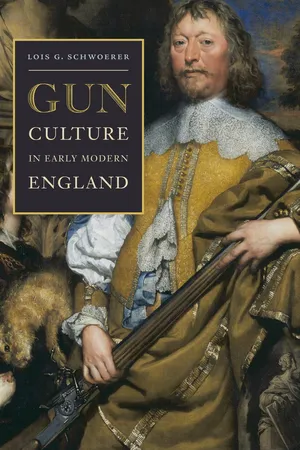
- 272 pages
- English
- ePUB (mobile friendly)
- Available on iOS & Android
Gun Culture in Early Modern England
About This Book
Guns had an enormous impact on the social, economic, cultural, and political lives of civilian men, women, and children of all social strata in early modern England. In this study, Lois Schwoerer identifies and analyzes England's domestic gun culture from 1500 to 1740, uncovering how guns became available, what effects they had on society, and how different sectors of the population contributed to gun culture.
The rise of guns made for recreational use followed the development of a robust gun industry intended by King Henry VIII to produce artillery and handguns for war. Located first in London, the gun industry brought the city new sounds, smells, street names, shops, sights, and communities of gun workers, many of whom were immigrants. Elite men used guns for hunting, target shooting, and protection. They collected beautifully decorated guns, gave them as gifts, and included them in portraits and coats-of-arms, regarding firearms as a mark of status, power, and sophistication. With statutes and proclamations, the government legally denied firearms to subjects with an annual income under £100—about 98 percent of the population—whose reactions ranged from grudging acceptance to willful disobedience.
Schwoerer shows how this domestic gun culture influenced England's Bill of Rights in 1689, a document often cited to support the claim that the Second Amendment to the United States Constitution conveys the right to have arms as an Anglo-American legacy. Schwoerer shows that the Bill of Rights did not grant a universal right to have arms, but rather a right restricted by religion, law, and economic standing, terms that reflected the nation's gun culture. Examining everything from gunmakers' records to wills, and from period portraits to toy guns, Gun Culture in Early Modern England offers new data and fresh insights on the place of the gun in English society.
Frequently asked questions
Information
| BC | Burney Collection of Seventeenth- and Eighteenth-Century Newspapers (digitized), British Library |
| BL | British Library |
| CJ | Parliament, Great Britain, Journals of the House of Commons, 11 volumes |
| CSPD | Calendar of State Papers, Domestic Series, 1553–1714 |
| DNB | H. C. G. Matthew and Brian Harrison, eds., Oxford Dictionary of National Biography, 60 volumes |
| HEHL | Henry E. Huntington Library, San Marino, California |
| HMSO | Her or His Majesty’s Stationery Office |
| NA | National Archives, London |
| OED | Oxford English Dictionary |
| SP | State Papers |
| SR | Alexander Luders et al., eds., Statutes of the Realm, 11 volumes |
Table of contents
- Cover Page
- Title Page
- Copyright
- Contents
- Acknowledgments
- Introduction
- One: Re-creating and Developing a Gun Industry
- Two: Economic Opportunities for Men and Women
- Three: Regulating Domestic Guns with “Good and Politic Statutes”
- Four: Domestic Gun Licenses Issued “As if under the Great Seal”
- Five: Military Service: A Pathway to Guns
- Six: London: The Gun Capital of England
- Seven: “Newfangled and Wanton Pleasure” in the Many Lives of Men
- Eight: Guns: A Challenge to the Feminine Ideal?
- Nine: Guns and Child’s Play
- Ten: An Individual Right to Arms?: The Bill of Rights (1689)
- Conclusion: Defining Gun Culture in Early Modern England
- Appendix A What Is a Gun?
- Appendix B Naming the Gun
- Notes
- Bibliography
- Index